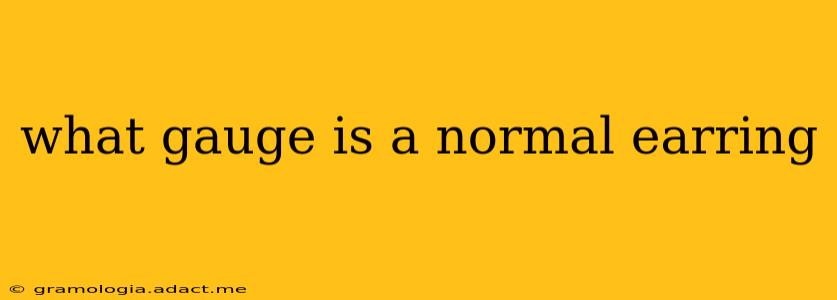What Gauge is a Normal Earring?
The term "normal" is subjective when it comes to earring gauge. What's considered normal depends largely on personal preference, current fashion trends, and the piercing's location. However, we can explore the most common gauges used for different ear piercings to give you a clearer understanding.
What is Earring Gauge?
Before we delve into what's considered "normal," it's important to understand what earring gauge means. Gauge refers to the thickness of the earring post, measured in millimeters (mm) or gauge numbers. A smaller gauge number indicates a thicker post, while a larger gauge number signifies a thinner post. For example, a 20-gauge earring is thinner than a 16-gauge earring.
Common Earring Gauges and Their Uses:
-
20 Gauge (0.8mm): This is arguably the most common gauge for initial ear piercings, particularly for lobe piercings. It's considered a standard size for everyday wear due to its comfortable balance between being thin enough to heal well and thick enough to be durable. Many starter earrings are 20 gauge.
-
18 Gauge (1.0mm): Slightly thicker than 20 gauge, this size is also frequently used for lobe piercings, particularly if someone desires a slightly heavier or more substantial-looking earring. It offers slightly more versatility in terms of earring styles.
-
16 Gauge (1.2mm): This gauge is often used for cartilage piercings (like helix, tragus, or daith piercings), and occasionally for lobe piercings. It’s thicker and stronger than 20 or 18 gauge, offering more support for heavier earrings.
-
Larger Gauges (14g, 12g, and beyond): Larger gauges (like 14g, 12g, etc.) are generally used for stretched piercings, where the piercing hole is intentionally enlarged over time. These gauges are not considered "normal" for initial piercings.
What Gauge is Best for My First Ear Piercing?
For a first ear lobe piercing, a 20-gauge earring is typically recommended. This size is thin enough to minimize discomfort during healing, yet robust enough to withstand daily wear. Your piercer will be able to guide you toward the appropriate size based on your anatomy.
What Gauge Should I Use for Cartilage Piercings?
Cartilage piercings often require a slightly thicker gauge for structural support, given the thicker and more rigid tissue. 16-gauge or sometimes even 14-gauge earrings are frequently used for initial cartilage piercings. Again, consult with your piercer for the most appropriate gauge.
Can I Wear Different Gauges in the Same Ear?
Technically, you can wear different gauges in the same ear if you have multiple piercings, but it's crucial to choose the right size for each piercing location and type. It is always recommended to use the appropriate gauge recommended by your piercer based on the placement of the piercing and the thickness of your tissues.
Are Thicker Gauge Earrings More Durable?
Generally, yes. Thicker gauges are less prone to bending or breaking, especially when supporting heavier earrings. However, the trade-off is that they can sometimes be more noticeable.
Remember, always consult a professional piercer for advice tailored to your individual needs and anatomy. They're the best resource for determining the appropriate gauge for your specific piercing. Proper piercing and aftercare are vital for preventing complications and ensuring a successful healing process.
